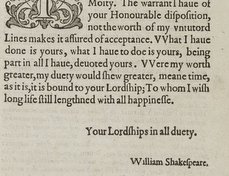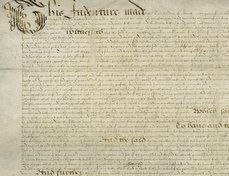Reproduced by permission of Shakespeare Birthplace Trust
Terms of use
The Shakespeare Birthplace Trust has graciously contributed images under a Creative Commons Attribution NonCommerical ShareAlike 4.0 International license. Visitors may download, link to and cite the images for personal research only. Any further use, including, but not limited to, unauthorized downloading or distribution of the images, commercial or third party use, is strictly prohibited. Visitors must contact the Shakespeare Birthplace Trust to request additional use, at: images.scla@shakespeare.org.uk
Document-specific information
Date: October 2, 1556
Repository: Shakespeare Birthplace Trust, Stratford-upon-Avon, UK
Call number and opening: BRU15/7/40
View online bibliographic record
Robert Bearman, "Presentment at Stratford-upon-Avon’s court leet that John Shakespeare had bought a house in Greenhill Street from George Turner and a house in Henley Street that became part of the Birthplace from Edward West," Shakespeare Documented, https://doi.org/10.37078/751.
Shakespeare Birthplace Trust, BRU15/7/40. See Shakespeare Documented, https://doi.org/10.37078/751.
At Stratford’s court leet - originally a manorial court with delegated authority in minor criminal matters – held on October 2, 1556, the jury reported two recent purchases by John Shakespeare. This was in line with the occasional practice in the 1550s that transfers of freehold property in Stratford should be registered in this way. Although freehold property could be freely bought, sold or bequeathed (hence the term freehold), tenure might still involve payments of a chief (or ground) rent to the lord of the manor and a theoretical obligation to attend the manorial court. Hence there was a need to keep track of property transfers.
John purchased the first property, a tenement, with garden and croft (a small enclosed piece of land) in Greenhill Street, from George Turner, a well-to-do clothier serving the Stratford Corporation as a Capital Burgess. The property was subject to an annual chief rent of 6 pence, which indicates it had a street frontage of about 30-35 feet. Nothing further is known about John Shakespeare’s tenure of this property. Perhaps it was sold off when he ran into financial difficulties in the late 1570s.
His second purchase was of a house and garden in Henley Street which he bought from Edward West. This also carried the obligation of an annual chief rent of six pence, so was roughly the same size as the Greenhill Street property. In April 1552, John had been fined with two other men at the court leet for allowing a muckheap to accumulate in Henley Street, indicating that all three probably lived in the street. If so, then John could have been a tenant in the house that he had eventually bought by October 1556, as recorded here.
The proceedings of the court leet that day were recorded on two sides of a single sheet of paper. The first image shows one side of the sheet, beginning with a formal statement of the name of the court and the date it was held, followed by the names of the jurors, set out in columns. The record of John Shakespeare’s purchases, and of a third transfer of freehold property registered that day, was the last matter considered that day and are the subject of the last paragraph on the other side of the sheet, shown in image two and detailed in image three.
The site of this Henley Street property can be identified with some confidence. In 1590, when a survey was carried out on the death of the lord of the manor, John Shakespeare’s property in Henley Street (since identified as the site of the Birthplace) was listed as two adjacent tenements, owing chief rents of 6 pence and 13 pence in that order. As the properties in the street were listed from the south-east to the north-west, it is reasonable to assume that the first tenement, charged with 6 pence, is the one which John purchased in 1556, also subject to the same rent, and that it stood on the south-east part of the Birthplace site. This to some extent confirmed by a deed of 1575 which shows John in possession of this property.
Written by Robert Bearman
Last updated July 11, 2020













